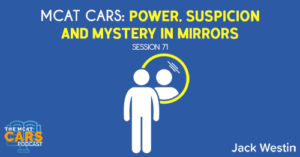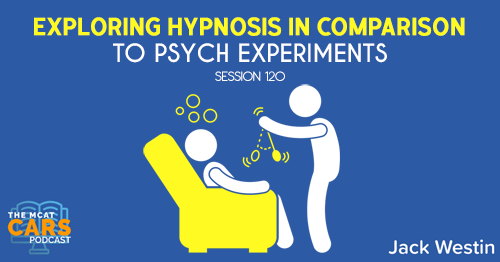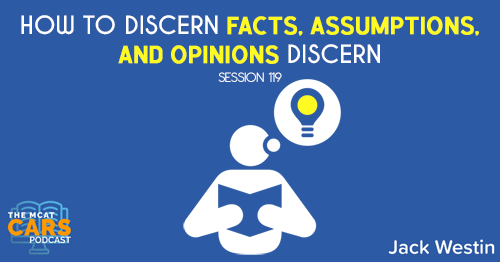Apple Podcasts | Google Podcasts

Session 71
This MCAT CARS passage looks at the history of mirrors and the intangible power they hold over us.
Once again, Jack Westin joins us today for another exciting dive into a great passage.
Our passage today is similar to Passage 18 of the CARS Question Pack Volume 2 on Neanderthals. Jack suggests grabbing this AAMC material.
[02:33] Should I Buy AAMC Review Materials?
AAMC is the must-have resource that every student should buy before anything else. You have to go to the source that made the test. Get their resources and practice that.
AAMC is the gold standard. You can’t beat their practice materials. There are not many passages in the AAMC question pack so make sure you do them all and review them thoroughly.
'AAMC products are from the people who actually make the test.'Click To TweetBuy the materials in a bundle so it’s more cost-effective than buying them individually. Get the flashcards too! Jack says the flashcard questions can appear on the test. They test basic concepts on this test. Digital flashcards won’t hurt.
Consume anything that AAMC has and don’t do it too late in the process. Do it early on. Start looking at the section bank, the CARS question pack. And don’t save them for later. Practice them months in advance.
Anything the AAMC offers, buy it!
Link to article:
https://longreads.com/2019/07/11/the-ugly-history-of-beautiful-things-mirrors/
Eight thousand years ago, a craftsperson sat inside their mud-brick house in Turkey and rubbed a piece of obsidian with their hands, smoothing the surface carefully, polishing the stone until it shone darkly in the hot sun, burning a piece of volcanic rock into something miraculous. In this piece of black stone, they could see their reflection, surrounded by the walls of their dwelling, built on the bones of their ancestors, the painted plaster walls rendered colorless by the obsidian’s deep gloss. But they weren’t done. They took white plaster and applied it to one side of this stone disk in a conical shape. Eventually this stone came to rest in a grave, alongside a woman from the early agricultural society. There it stayed until archeologists found it in the 1960s. It is, as far as we know, one of humankind’s first mirrors.
According to archeologist Ian Hodder, who oversees the hilly, 34-acre archeological site at Çatalhöyük in central Turkey, there have been “five or six” obsidian mirrors found there, all located in the northeast corners of tombs belonging to women. “They are beautiful things,” he says of the Neolithic mirrors. “Nobody really expected there would be things like mirrors in those early days. These are the first sort of settlements after people have been living as hunters and gathers. In many ways, these were quite simple societies, so it is odd.” Yet these early proto-urban people clearly wanted to look at themselves — or at something. It’s possible they were used in rituals by shamans or other religious figures. “One of the most commonly suggested for the time period is that they’re something to do with predicting the future or understanding the spirit world through reading images in the mirrors,” says Hodder. We just don’t know. We’ll probably never know.
With a name taken from the Latin mirare and mirari (“to look at” and “to wonder at, admire,” respectively), a mirror can be any reflective surface created for the purpose of seeing oneself. They can be made of stone, metal, glass, plastic, or even water. Throughout history, we’ve constructed mirrors from all those substances, to a varying degree of efficacy, for various reasons. Some were used as ceremonial items, others were used to repel malevolent spirits, and still others were used for the simple pleasure of examining one’s countenance.
But no matter what they’re made of, mirrors are objects of mystery, obsession, and fear. They’re simple yet complex. They’ve been used for purposes both sacred and profane. We love them, yet we’re loath to admit it. Even their creation has been shrouded in secrecy and aided by willful ignorance and sometimes outright violence; mirror making was once a toxic affair, and its secrets were guarded by laws and punishable by death. Long reserved for the wealthy few, we now walk around with compact mirrors in our pockets, and even if you left yours at home, there’s always a cell phone screen that can function, if you want it to, if the light is right, as a mirror.
Often, when objects become mundane, they lose some of their luster. But mirrors retain their ability to hold our attention, and they retain a certain amount of power over us. We’re still interested in seeing our reflections, and we still want to know what the future holds. Yet we’ve lost the reverence we once had for them. We no longer bury our dead with hand mirrors, and we don’t often speak of the control a mirror can exert over a person. Instead, we allow this force to alter our perceptions, to diminish our happiness, while denying its power. Looking in a mirror is just something you do — just something women do. We’re so used to seeing this impulse as vanity that most of us have forgotten the innate sense of awe that comes with looking. We’ve forgotten how to face our reflections not with judgment or fear, but with a sense of joyful discovery, a sense of hope. We can see our reflections anywhere, yet still face the mirror with a certain amount of suspicion, as though desiring knowledge of how the world sees you is somehow wrong.
[05:44] Paragraph 1, Sentence 1
Eight thousand years ago, a craftsperson sat inside their mud-brick house in Turkey and rubbed a piece of obsidian with their hands, smoothing the surface carefully, polishing the stone until it shone darkly in the hot sun, burning a piece of volcanic rock into something miraculous.
Jack says:
We’re given a timeline here. Visualize this mud hut in Turkey and the beautiful piece of obsidian.
[06:23] Paragraph 1, Sentence 2
In this piece of black stone, they could see their reflection, surrounded by the walls of their dwelling, built on the bones of their ancestors, the painted plaster walls rendered colorless by the obsidian’s deep gloss.
Jack says:
The author is painting a picture of this black stone acting as a mirror.
[06:55] Paragraph 1, Sentences 3-4
But they weren’t done. They took white plaster and applied it to one side of this stone disk in a conical shape.
Jack says:
They’re making something out.
[07:12] Paragraph 1, Sentence 5
Eventually this stone came to rest in a grave, alongside a woman from the early agricultural society.
Jack says:
The author is telling us how we know what this looked like because it was in the grave.
[07:30] Paragraph 1, Sentence 6
There it stayed until archeologists found it in the 1960s.
Jack says:
This object was found in a dig.
[07:39] Paragraph 1, Sentence 7
It is, as far as we know, one of humankind’s first mirrors.
Jack says:
So they’re basically making a mirror.
[08:08] Paragraph 2, Sentence 1
According to archeologist Ian Hodder, who oversees the hilly, 34-acre archeological site at Çatalhöyük in central Turkey, there have been “five or six” obsidian mirrors found there, all located in the northeast corners of tombs belonging to women.
Jack says:
We’re given a location in Turkey where there’s a big dig going on.
[08:46] Paragraph 2, Sentence 2
“They are beautiful things,” he says of the Neolithic mirrors.
Jack says:
Ian Hodder is describing these mirrors.
[08:53] Paragraph 2, Sentence 3
“Nobody really expected there would be things like mirrors in those early days.
Jack says:
Some opinions on what they expected to find and what they did find.
[09:04] Paragraph 2, Sentence 4
These are the first sort of settlements after people have been living as hunters and gathers.
Jack says:
We’re given a timeline of our ancestor settlements and what they were finding there.
[09:23] Paragraph 2, Sentence 5
In many ways, these were quite simple societies, so it is odd.”
Jack says:
The archaeologist is saying it’s odd to find these mirrors because they were simple societies.
[09:42] Paragraph 2, Sentence 6
Yet these early proto-urban people clearly wanted to look at themselves — or at something.
Jack says:
We don’t know why they’re using mirrors for. And that something could be more figurative than literal. Let’s see.
[09:59] Paragraph 2, Sentence 7
It’s possible they were used in rituals by shamans or other religious figures.
Jack says:
They could be used in other places.
[10:08] Paragraph 2, Sentence 8
“One of the most commonly suggested for the time period is that they’re something to do with predicting the future or understanding the spirit world through reading images in the mirrors,” says Hodder.
Jack says:
Maybe the mirrors were thought of to be magical.
[11:00] Paragraph 2, Sentences 9-10
We just don’t know. We’ll probably never know.
Jack says:
So this paragraph is saying it’s unusual for them to have mirrors because they were a simple society. But we don’t really know what they were using them for.
They’re bringing this up in terms of both angles – themselves and rituals and religion.
[12:02] Paragraph 3, Sentence 1
With a name taken from the Latin mirare and mirari (“to look at” and “to wonder at, admire,” respectively), a mirror can be any reflective surface created for the purpose of seeing oneself.
Jack says:
Here’s a little bit of history on the name and what the mirror is used for.
[12:20] Paragraph 3, Sentence 2
They can be made of stone, metal, glass, plastic, or even water.
Jack says:
The author is stating the materials for mirrors.
[12:29] Paragraph 3, Sentence 3
Throughout history, we’ve constructed mirrors from all those substances, to a varying degree of efficacy, for various reasons.
Jack says:
This is a little more history on mirrors.
[12:43] Paragraph 3, Sentence 4
Some were used as ceremonial items, others were used to repel malevolent spirits, and still others were used for the simple pleasure of examining one’s countenance.
Jack says:
This paragraph is more about the history of mirrors.
[13:10] Paragraph 4, Sentence 1
But no matter what they’re made of, mirrors are objects of mystery, obsession, and fear.
Jack says:
The author is bringing up a cultural or spiritual meaning of what mirrors are. We’re getting on a deeper level here. The previous paragraph was more functional and basic. Now, it’s getting a little bit deeper.
[13:35] Paragraph 4, Sentence 2
They’re simple yet complex.
Jack says:
They’re simple things but complex in how we potentially use them and the meaning we make from it.
[13:48] Paragraph 4, Sentence 3
They’ve been used for purposes both sacred and profane.
Jack says:
The author gives a deeper meaning for them.
[13:55] Paragraph 4, Sentence 4
We love them, yet we’re loath to admit it.
Jack says:
We don’t want to admit that we like looking at ourselves in the mirror.
[14:06] Paragraph 4, Sentence 5
Even their creation has been shrouded in secrecy and aided by willful ignorance and sometimes outright violence; mirror making was once a toxic affair, and its secrets were guarded by laws and punishable by death.
Jack says:
Another history here that goes back to the first sentence about obsession and fear of dying if we figure out how we make them. Maybe it’s against the law.
[14:43] Paragraph 4, Sentence 6
Long reserved for the wealthy few, we now walk around with compact mirrors in our pockets, and even if you left yours at home, there’s always a cell phone screen that can function, if you want it to, if the light is right, as a mirror.
Jack says:
The author is showing the difference between what used to be and what is now. Imagine not being able to get a mirror because if you did, you die.
So in this paragraph, just know it’s about mystery, obsession, and fear. That first sentence really resonates throughout this paragraph.
[15:47] Paragraph 5, Sentence 1
Often, when objects become mundane, they lose some of their luster.
Jack says:
Mirrors are boring now and not as secretive because everyone has one. And luster refers to shiny and it’s special.
[16:17] Paragraph 5, Sentence 2
But mirrors retain their ability to hold our attention, and they retain a certain amount of power over us.
Jack says:
The author is pointing out that they’re not as special anymore but they still do something to us. They hold our attention and control us in some way.
[16:33] Paragraph 5, Sentence 3
We’re still interested in seeing our reflections, and we still want to know what the future holds.
Jack says:
This goes back to the mystery and the obsession that have power over us.
[17:10] Paragraph 5, Sentence 4
Yet we’ve lost the reverence we once had for them.
Jack says:
We don’t hold mirrors in the same position in society of this sacred thing and that only the wealthy have them. But they still kind of control us.
[17:24] Paragraph 5, Sentence 5
We no longer bury our dead with hand mirrors, and we don’t often speak of the control a mirror can exert over a person.
Jack says:
We don’t go around saying a person is addicted to mirrors.
[18:01] Paragraph 5, Sentence 6
Instead, we allow this force to alter our perceptions, to diminish our happiness, while denying its power.
Jack says:
Just thinking through this, it’s a society of body dysmorphic stuff. For instance, people with eating disorders look at themselves and they alter their perceptions.
[18:29] Paragraph 5, Sentences 7-8
Looking in a mirror is just something you do — just something women do. We’re so used to seeing this impulse as vanity that most of us have forgotten the innate sense of awe that comes with looking.
Jack says:
This ties back to this obsession, mystery, this awe, this dangerous power.
[19:07] Paragraph 5, Sentence 9
We’ve forgotten how to face our reflections not with judgment or fear, but with a sense of joyful discovery, a sense of hope.
Jack says:
The author is painting a picture of how mirrors can be used in society with this discovery and hope.
[19:35] Paragraph 5, Sentence 10
We can see our reflections anywhere, yet still face the mirror with a certain amount of suspicion, as though desiring knowledge of how the world sees you is somehow wrong.
Jack says:
The mirror still holds so much power over us with how we think about it and how we fear what we see in it.
[20:18] The Main Idea
The passage started off talking about the early mirrors and went into talking about its function. Then its powers and how they’re everywhere. But then alluding back to the powers, the suspicion, the mystery.
The author is trying to say that we love mirrors and have them everywhere. But they have this dangerous power over us. Whether we have them everywhere or not, it doesn’t matter. It’s still powerful.
If you understand that picture the author is painting about mirrors, then you’re going to be fine. It’s what you need to know.
[21:55] Final Thoughts
Just focus on the innate desire to understand and learn and explore. This will help students as they go through this process. Some passages are more interesting than others. And for this passage, you might have some connection to it. So you have a better time understanding the nuances the author has presented.
Accept that you may get something that you don’t like. But for the person who wrote it, it’s very interesting. Change your perspective on this and you’ll have some sort of connection to anything you read. And you’ll be able to explain it to your friends and family or at least understand it better for yourself.
'If you change your perspective and attitude towards everything you read, everything will be interesting.'Click To TweetLinks:
AAMC’s CARS Question Pack Volume 2
Link to article:
https://longreads.com/2019/07/11/the-ugly-history-of-beautiful-things-mirrors/
SEARCH SITE
SEARCH SITE
LISTEN FOR FREE











